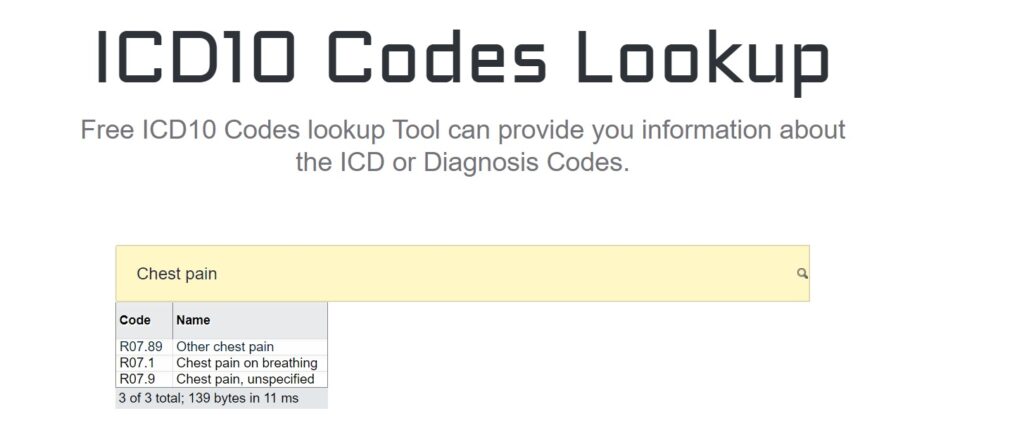Chest pain is a common symptom experienced by many individuals, and serves as an important indicator of potentially serious disease processes. The origin of chest pain can be classified into non-cardiac (musculoskeletal, pulmonary, gastrointestinal) and cardiac (myocardial ischemia/infarction) causes. Although chest pain can often be self-managed with over the counter medications for a benign cause, medical attention is warranted if symptoms are severe or occur suddenly. ICD 10 Code for Chest Pain is R07.9 (unspecified).
These scenarios may point to an underlying cardiac disorder, which, if not treated early, can lead to more serious consequences. A detailed clinical evaluation that includes history, physical examination, diagnostic tests (electrocardiogram-ECG, blood work) and imaging studies (chest X-ray or computed tomography – CT scan) is advised to determine the origin of the chest pain. can be properly diagnosed and treated accordingly.
ICD 10 Code for Chest Pain 2023
The ICD 10 code for chest pain is R07.9 for Chest pain, unspecified. All other related chest pain codes are as below, you can also check on Free ICD10 Codes Lookup Tool

ICD-10-CM codes adjacent to R07.9 are as under,
- R07.9 Chest pain, unspecified: When the nature or location of chest pain is not clearly defined, this code might be used to indicate unspecified chest pain.
- R06.89 Other abnormalities of breathing: This code is used to classify conditions that involve unusual or abnormal breathing patterns that do not fall under other specific categories. It’s a catch-all code for various breathing issues that don’t have a more precise code.
- R06.9 Unspecified abnormalities of breathing: Similar to the previous code, this is a broader code used when the exact nature of the breathing abnormality is not specified. It’s used when more information is needed to pinpoint the exact problem.
- R07 Pain in throat and chest: This code is used for cases where a patient complains of Pain in both the throat and chest. It’s a general code and doesn’t specify the cause of the Pain.
- R07.0 Pain in throat: This code is specific to Pain localized to the throat area. It doesn’t include chest pain or Pain in other regions.
- R07.1 Chest pain on breathing: This code is used when a patient experiences chest pain, specifically when breathing. This could be caused by various conditions affecting the chest and respiratory system.
- R07.2 Precordial Pain: Precordial Pain refers to Pain felt in the area of the chest overlying the heart. This code is used for such cases of Pain.
- R07.8 Other chest pain: If the chest pain doesn’t fit into any of the more specific categories mentioned above, this code might be used to classify it as a different type of chest pain.
- R07.81 Pleurodynia: Pleurodynia refers to Pain in the muscles between the ribs. It’s often associated with viral infections and is characterized by sharp, stabbing pains.
- R07.82 Intercostal Pain: This code is used for Pain that specifically occurs in the intercostal muscles, which are the muscles between the ribs.
- R07.89 Other chest pain: Similar to the previous “other chest pain” code, this one is used when the chest pain doesn’t fit into the more specific categories provided.
- R09.0 Asphyxia and hypoxemia: This code encompasses cases of asphyxia (severe oxygen deficiency leading to unconsciousness or death) and hypoxemia (low oxygen levels in the blood).
- R09.01 Asphyxia: Specifically used for cases where a severe lack of oxygen leads to suffocation or unconsciousness.
- R09.02 Hypoxemia: Used for cases with a documented condition of abnormally low oxygen levels in the blood.
- R09.1 Pleurisy: This code is assigned when a patient is diagnosed with pleurisy, which is inflammation of the pleura (the lining of the lungs and chest cavity).
- R09.2 Respiratory arrest: This code is used when a person experiences a sudden cessation of breathing.
- R09.3 Abnormal sputum: This code is assigned when a patient presents with abnormal characteristics in their sputum (mucus coughed up from the respiratory tract).
- R09.8 Other specified symptoms and signs involving the circulatory and respiratory systems: Similar to other “other specified” codes, and this one is used for symptoms that do not fit the specific categories mentioned earlier.
- R09.81 Nasal congestion: This code is used for cases of nasal congestion, where the nasal passages are blocked or stuffed.
- R09.82 Postnasal drip: Postnasal drip is the sensation of mucus running down the back of the throat from the nasal passages. This code is used to classify such cases.
For check other ICD10 Codes please visist
Causes of chest pain
Chest pain can have many causes, and it is important to differentiate between them to ensure proper treatment. Following are some of the causes of chest pain-
◆ Common causes of chest discomfort may include musculoskeletal tension, gastroesophageal reflux, or benign sources such as psychiatric disorders.
◆Lung disease- Chest pain can also be experienced due to lung disease. In this condition, there is pain in the side of the chest and this pain increases during breathing or coughing. Common causes of chest pain are inflammation in the lining of the lungs (pleura) that causes chest pain. Lung diseases such as pneumonia and asthma can also cause chest pain.
◆ However, more serious causes should also be sought and evaluated. Cardiac ischemia, myocardial infarction or bleeding of the pericardium from coronary artery disease are the most pressing issues that should be considered in a patient reporting chest pain.
◆TB can also be the main cause of chest pain.
Symptoms of Chest Pain
Chest pain is a primary symptom of many underlying medical conditions and should not be ignored. It may present as a sharp, stabbing pain; a persistent pain; or tightness in the chest that in some cases spreads outward. Other symptoms that may accompany chest pain include shortness of breath, dizziness, sweating, nausea and vomiting.It becomes important to seek medical help when experiencing any of the above, especially along with other possible indicators such as unexplained fatigue, fainting spells, or palpitations.
Effects of Chest Pain on Body
Chest pain is a symptom of a wide range of medical conditions and can leave a serious impact on the body. It can cause conditions ranging from muscle strains to cardiac arrest and creates both physical and psychological stress.Physically, chest pain can seriously affect the heart, arrhythmia or palpitations, difficulty breathing or chest tightness, pressure or fullness in the chest as well as spreading to other areas of the body such as the shoulders, neck Chest pain is very fatal with the symptoms of sharp pain. In addition to this physical discomfort, chest pain can also target fear responses such as shortness of breath, sweating, and increased heart rate. In addition, it often disrupts sleep patterns, leading to chronic fatigue, increased irritability, and reduced work productivity.
How to protect ourself from Chest pain?
Protecting yourself from chest pain becomes a very important part of overall health and wellness when you are a heart patient. An important first step is to identify risk factors such as eating unhealthy foods, smoking, being physically inactive, and having a family history of heart disease. Limiting these behaviors can help reduce your risk of chest pain or other heart-related problems.Additionally, individuals should ensure that they are having regular checkups with their healthcare provider and following any recommended treatment plans prescribed by their doctor for pre-existing conditions. With regard to activity levels, it is advised to gradually build up to tolerated levels of physical activity – with approved permission from a physician – in order to allow for proper adaptation and reduce the likelihood of chest pain.
FAQs
Ans. Other helpful strategies for reducing chest pain include proper nutrition that includes reduction of processed food products and saturated fat; Managing stress through regular relaxation exercises such as stretching or yoga.
Ans. The main reason for tightness in the chest is mucus, which we also call phlegm. The problem of chest congestion usually occurs when, due to any reason, more phlegm starts forming in the body and it starts freezing there.
Conclusion:
Today, through this post, we have come to know what is chest pain and what are the remedies for chest pain. What are the causes of chest line and what are its symptoms and how it affects the body, we can avoid such situations by adopting physical exercise like yoga by improving daily lifestyle. Chest pain can be very fatal if it is not diagnosed on time. Any prolonged effect should be medically evaluated for proper diagnosis and treatment to reduce further complications of chest pain.
Related Articles:
ICD 10 Code for Cough | Diagnosis Codes Cough
Pain in Knees ICD 10|ICD 10 Code For Knee Pain

